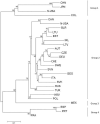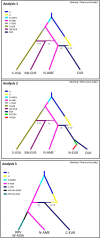Diversity, migration routes, and worldwide population genetic structure of Lecanosticta acicola, the causal agent of brown spot needle blight
- PMID: 35957598
- PMCID: PMC9562577
- DOI: 10.1111/mpp.13257
Diversity, migration routes, and worldwide population genetic structure of Lecanosticta acicola, the causal agent of brown spot needle blight
Abstract
Lecanosticta acicola is a pine needle pathogen causing brown spot needle blight that results in premature needle shedding with considerable damage described in North America, Europe, and Asia. Microsatellite and mating type markers were used to study the population genetics, migration history, and reproduction mode of the pathogen, based on a collection of 650 isolates from 27 countries and 26 hosts across the range of L. acicola. The presence of L. acicola in Georgia was confirmed in this study. Migration analyses indicate there have been several introduction events from North America into Europe. However, some of the source populations still appear to remain unknown. The populations in Croatia and western Asia appear to originate from genetically similar populations in North America. Intercontinental movement of the pathogen was reflected in an identical haplotype occurring on two continents, in North America (Canada) and Europe (Germany). Several shared haplotypes between European populations further suggests more local pathogen movement between countries. Moreover, migration analyses indicate that the populations in northern Europe originate from more established populations in central Europe. Overall, the highest genetic diversity was observed in south-eastern USA. In Europe, the highest diversity was observed in France, where the presence of both known pathogen lineages was recorded. Less than half of the observed populations contained mating types in equal proportions. Although there is evidence of some sexual reproduction taking place, the pathogen spreads predominantly asexually and through anthropogenic activity.
Keywords: Mycosphaerella dearnessii; Pinus; forest pathology; introduction pathways; invasive pathogen; mating type; microsatellites.
© 2022 The Authors. Molecular Plant Pathology published by British Society for Plant Pathology and John Wiley & Sons Ltd.
Conflict of interest statement
The authors declare that they have no conflicts of interest.
Figures







Similar articles
-
Genetic Analyses Suggest Separate Introductions of the Pine Pathogen Lecanosticta acicola Into Europe.Phytopathology. 2016 Nov;106(11):1413-1425. doi: 10.1094/PHYTO-10-15-0271-R. Epub 2016 Aug 17. Phytopathology. 2016. PMID: 26714104
-
A look into the genetic diversity of Lecanosticta acicola in northern Europe.Fungal Biol. 2019 Oct;123(10):773-782. doi: 10.1016/j.funbio.2019.06.012. Epub 2019 Jul 12. Fungal Biol. 2019. PMID: 31542194
-
The increasing threat to European forests from the invasive foliar pine pathogen, Lecanosticta acicola.For Ecol Manage. 2023 May 15;536:120847. doi: 10.1016/j.foreco.2023.120847. For Ecol Manage. 2023. PMID: 37193248 Free PMC article.
-
Remote sensing-based detection of brown spot needle blight: a comprehensive review, and future directions.PeerJ. 2025 May 22;13:e19407. doi: 10.7717/peerj.19407. eCollection 2025. PeerJ. 2025. PMID: 40416626 Free PMC article. Review.
-
Assessment of the global pattern of genetic diversity in Echinococcus multilocularis inferred by mitochondrial DNA sequences.Vet Parasitol. 2018 Oct 15;262:30-41. doi: 10.1016/j.vetpar.2018.09.013. Epub 2018 Sep 27. Vet Parasitol. 2018. PMID: 30389009 Review.
Cited by
-
Genomics of the expanding pine pathogen Lecanosticta acicola reveals patterns of ongoing genetic admixture.mSystems. 2024 Mar 19;9(3):e0092823. doi: 10.1128/msystems.00928-23. Epub 2024 Feb 16. mSystems. 2024. PMID: 38364101 Free PMC article.
-
Genetic Diversity of Lecanosticta acicola in Pinus Ecosystems in Northern Spain.J Fungi (Basel). 2023 Jun 9;9(6):651. doi: 10.3390/jof9060651. J Fungi (Basel). 2023. PMID: 37367587 Free PMC article.
-
Oomycete Soil Diversity Associated with Betula and Alnus in Forests and Urban Settings in the Nordic-Baltic Region.J Fungi (Basel). 2023 Sep 14;9(9):926. doi: 10.3390/jof9090926. J Fungi (Basel). 2023. PMID: 37755034 Free PMC article.
References
-
- Adamčíková, K. , Jánošíková, Z. , Adamčík, S. , Ostrovský, R. , Pastirčáková, K. , Kobza, M. et al. (2021) Host range, genetic variability, and mating types of Lecanosticta acicola in Slovakia. Scandinavian Journal of Forest Research, 36, 325–332.
-
- Adamson, K. , Drenkhan, R. & Hanso, M. (2015) Invasive brown spot needle blight caused by Lecanosticta acicola in Estonia. Scandinavian Journal of Forest Research, 30, 587–593.
-
- Adamson, K. , Laas, M. , Drenkhan, R. & Hanso, M. (2018a) Quarantine pathogen Lecanosticta acicola, observed at its jump from an exotic host to the native scots pine in Estonia. Baltic Forestry, 24, 36–41.
-
- Adamson, K. , Mullett, M.S. , Solheim, H. , Barnes, I. , Müller, M.M. , Hantula, J. et al. (2018b) Looking for relationships between the populations of Dothistroma septosporum in northern Europe and Asia. Fungal Genetics and Biology, 110, 15–25. - PubMed
Publication types
MeSH terms
Supplementary concepts
LinkOut - more resources
Full Text Sources

